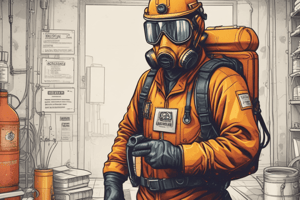Podcast
Questions and Answers
What is the new name for WHMIS?
What is the new name for WHMIS?
- Chemical Safety Communication System
- Global Harmonized System (correct)
- Global Hazard Control System
- National Chemical Information System
Which symbol would be used for a substance that can intensify a fire?
Which symbol would be used for a substance that can intensify a fire?
- Oxidizer (correct)
- Explosive
- Corrosive
- Flammable
What type of material is Hydrochloric acid classified as?
What type of material is Hydrochloric acid classified as?
- Flammable
- Corrosive (correct)
- Biohazardous
- Health Hazard
Which of the following examples is associated with acute toxicity?
Which of the following examples is associated with acute toxicity?
Which type of material includes infectious agents causing serious diseases?
Which type of material includes infectious agents causing serious diseases?
What condition is associated with materials that can cause serious health effects?
What condition is associated with materials that can cause serious health effects?
Which material is known to cause serious skin burns and eye irritation?
Which material is known to cause serious skin burns and eye irritation?
Which of the following materials is an example of a gas under pressure?
Which of the following materials is an example of a gas under pressure?
Flashcards are hidden until you start studying
Study Notes
WHMIS Overview
- WHMIS (Workplace Hazardous Material Information System) is a national hazard communication system in Canada.
- It provides crucial information on the safe use of hazardous products in workplaces.
- Transitioning to a new initiative, WHMIS is now part of the Global Harmonized System (GHS), aimed at standardizing chemical classification and communication globally.
GHS Symbols and Their Meanings
-
Gas Cylinder: Indicates gases under pressure, such as oxygen tanks.
-
Flammable: Represents materials that can easily catch fire, including propane gas.
-
Oxidizers: Materials that enhance the intensity of fires, exemplified by hydrogen peroxide.
-
Corrosive: Substances that chemically damage or destroy metals, causing severe skin burns and eye irritation; hydrochloric acid is a key example.
-
Explosive: Materials capable of self-reactivity or explosion, with potassium as a noted example.
-
Acute Toxicity: Refers to substances that can cause death or serious toxicity from short exposure to minimal amounts; carbon monoxide is a significant example.
-
Health Hazard: Materials that may cause or are suspected of causing serious health issues; asbestos is a notable example.
-
Irritants, Sensitizers, and Other Hazards: Chemicals that cause less severe health effects or damage to the ozone layer, such as various acids.
-
Biohazardous Infectious Materials: Includes infectious agents or biological toxins that can lead to serious diseases or death; used needles serve as a key example.
Studying That Suits You
Use AI to generate personalized quizzes and flashcards to suit your learning preferences.




